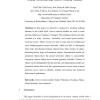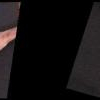182 search results - page 8 / 37 » Activity recognition using temporal evidence theory |
IJON
2002
13 years 8 months ago
2002
: In this paper we describe a method for tracking walking humans in the visual field. Active contour models are used to track moving objects in a sequence of images. The resulting ...
CVPR
2010
IEEE
13 years 6 months ago
2010
IEEE
We consider the `group motion segmentation' problem and provide a solution for it. The group motion segmentation problem aims at analyzing motion trajectories of multiple obj...
IMC
2007
ACM
13 years 10 months ago
2007
ACM
The increased use of botnets as an attack tool and the awareness attackers have of blocking lists leads to the question of whether we can effectively predict future bot locations...
CVPR
2003
IEEE
14 years 10 months ago
2003
IEEE
Video-based recognition and prediction of a temporally extended activity can benefit from a detailed description of high-level expectations about the activity. Stochastic grammars...
AAAI
2006
13 years 10 months ago
2006
This paper addresses the problem of activity recognition for physically-embodied agent teams. We define team activity recognition as the process of identifying team behaviors from...


